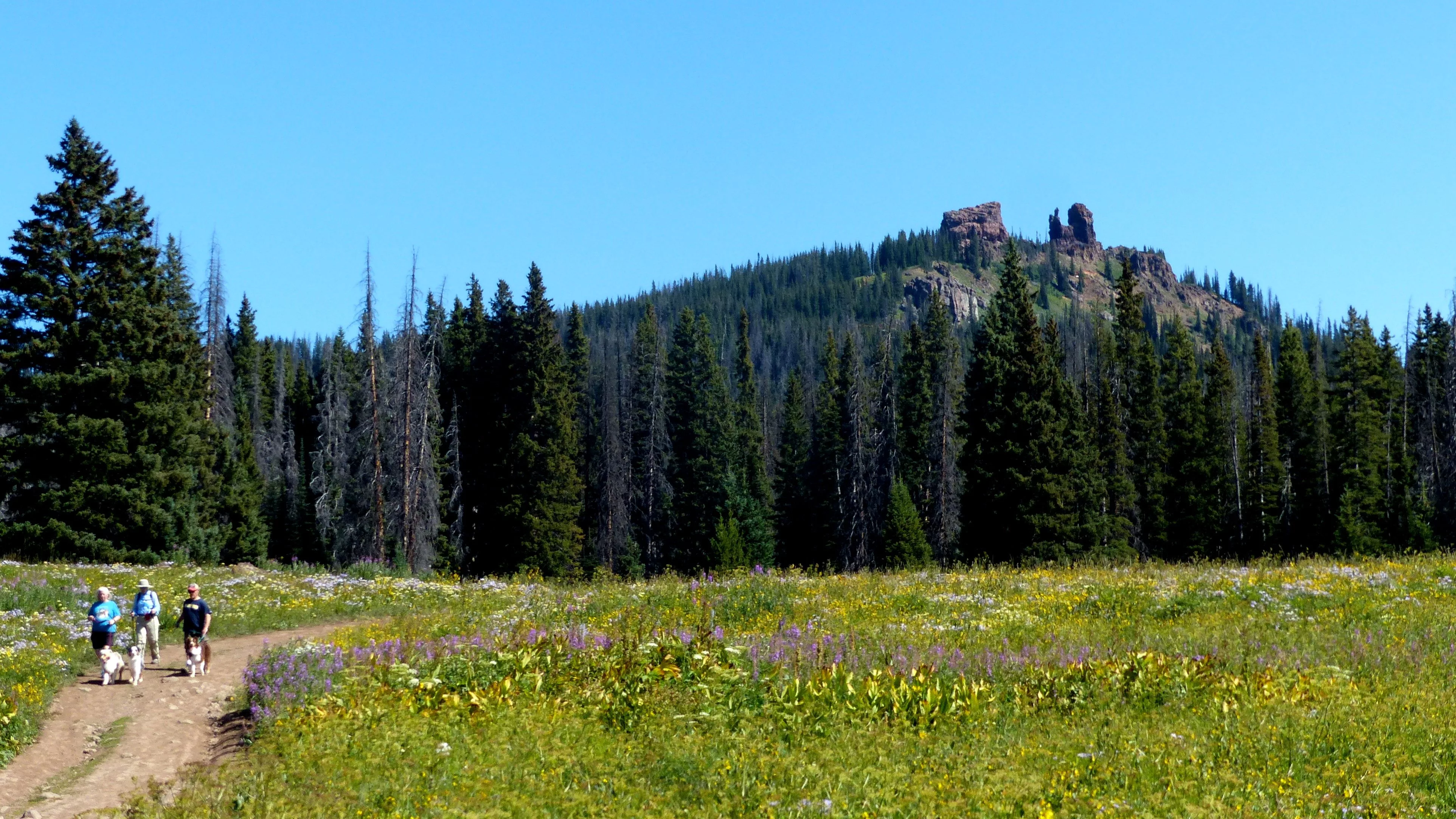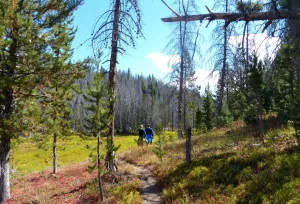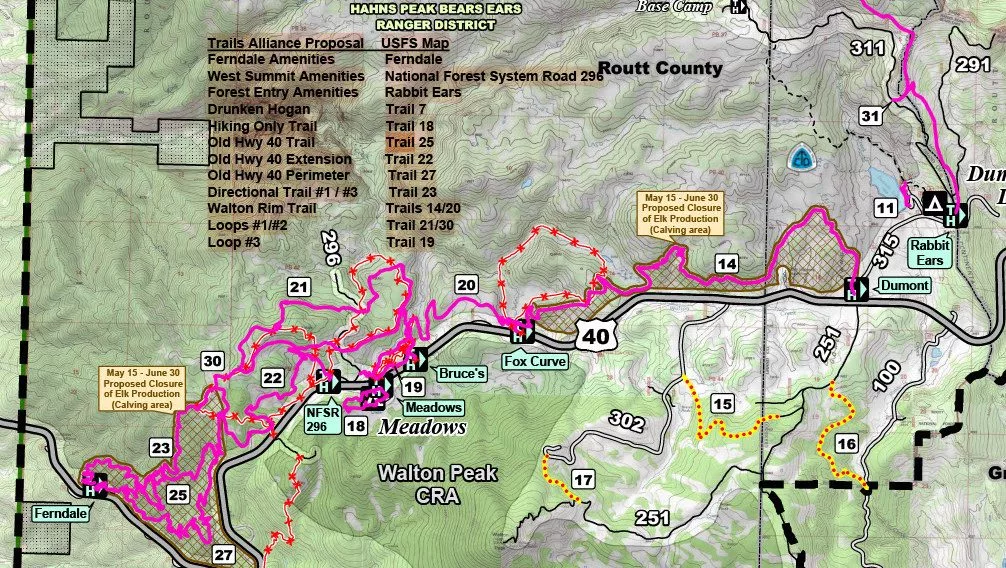
By Shannon Lukens. File photo from on Rabbit Ears Pass.
The Mad Rabbit Trails project in Routt County has received final approval from the U.S. Department of Agriculture Forest Service. It will include approximately 49 miles of new trails, with trailhead improvements to be used for hiking, cycling, adaptive users, and motorized. Most of the project trails will be along Highway 40, with varying abilities and uses, and loops.
Laraine Martin is the executive director of Routt County Riders. She says it will be a tremendous resource for the community.
“When you think about the experiences that you already have on some of the trails that have been created from this lodging tax fund, like a lot of the trails on Buff Pass, on Morning Gloria, NPR. It’s hard to imagine being here without those trails. And we’re about to have new experiences that we can treasure on Rabbit Ears Pass in an area that has been under utilized. I think the community is going to benefit immensely. It’s going to be a priceless resource.”
A map is below.
About 36 miles of routes that cross the project area will be rehabilitated to a natural state to protect resources and improve wildlife habitat. This will minimize impact to wetlands and wildlife habitat, and it will include seasonal wildlife closures during elk calving season.

This picture is of many with Routt County Riders, who have pushed for the new Mad Rabbit Trail system. It was taken in December of 2024, when the Mad Rabbit Trails Project was awarded $1.6 million from the City of Steamboat Springs to help with the amenities. It was a resolution passed by City Council, 5-2. The money is from the 2A for Trails ballot measure that passed in 2013. The forest service will also commit federal funds.
Dec. 4, 2024 from the Yampa Valley Bugle — U.S. Forest Service’s Mad Rabbit trails project gets $1.6 million from city of Steamboat Springs
Martin says Routt County Riders has been working on it for so long that it is a huge relief.
“We’ve been working on this for so long and pulling this boulder uphill that I feel it is a blend of relief and excitement and just the satisfaction of years upon years of sort of heavy advocacy and work to get this across some semblance of a finish line and this was a really, really big one that we’ve been stuck on for a long time, and to see it finally move forward in this way is deeply satisfying.”
In a press release late Thursday night from the forest service, it says public discussion and information has been gathered since 2018, by the Hahns Peak/Bears Ears Ranger District.
“The project demonstrates managing for a sustainable, diverse recreational trail system that conserves and minimizes impacts to natural resources such as wildlife.”
The Mad Rabbit Trails project is in the National Forest System, mainly near Rabbit Ears Pass, located in Routt, Grand, and Jackson counties. The project area encompasses the Mad Creek, Rocky Peak, Gunn Creek, Buffalo Pass, Fish Creek, Rabbit Ears Pass, and Steamboat Ski Resort areas.
The press release says implementation of the project will start as soon as possible.
Mad Rabbit Trails Project

Press Release from U.S. Forest Service U.S. Department of Agriculture; April 3, 2025.
Final Decision Notice signed for Mad Rabbit Trails Project
Public participation was a key element of the project since 2018.
(STEAMBOAT SPRINGS, Colo.) April 3, 2025 – The U.S. Department of Agriculture Forest Service has signed the final decision notice for the Mad Rabbit Trails project.
Public discussion and information gathering by the Hahns Peak/Bears Ears Ranger District, Routt National Forest has occurred since 2018. The project demonstrates managing for a sustainable, diverse recreational trail system that conserves and minimizes impacts to natural resources such as wildlife.
The project is located on National Forest System lands near the town of Steamboat Springs, Colo., in Routt, Grand, and Jackson counties. The project area encompasses the Mad Creek, Rocky Peak, Gunn Creek, Buffalo Pass, Fish Creek, Rabbit Ears Pass, and Steamboat Ski Resort areas.
Project documents and milestones can be reviewed at the project website.
The project decision includes approximately 49 miles of new trails, associated trailhead improvements, and additional management actions that would provide opportunities for a variety of users, both in terms of skill levels and types of use (hiking, cycling, adaptive users, motorized). Most of the project trails will occur along the Highway 40 corridor, creating both short and longer trail opportunities for varying abilities and uses, as well as loop opportunities.
To protect resources and improve wildlife habitat, approximately 36 miles of user-created routes across the project area will be rehabilitated to a natural state. Trail alignments are designed to minimize impacts to sensitive resources (wetlands, riparian areas, sensitive plant and wildlife habitat, etc.) and seasonal wildlife closures will be placed on certain high priority habitat areas to lower impacts during elk calving season.
To deter further unauthorized user-created trail development and to protect resources, a Forest Order will be implemented to prohibit mountain bike and other wheeled vehicle use off designated National Forest System trails and roads across the entire project area of 127,124 acres.
Implementation of the project is expected to begin as soon as possible.
-USDA-
